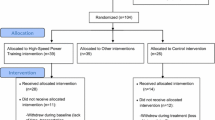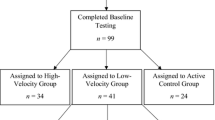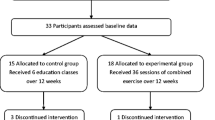Abstract
Background
Little is known about the comparative effect of aerobic training (AT) versus resistance training (RT) on gait speed, a strong predictor of disability.
Aims
To compare the effect of AT versus RT on gait speed and other functional measures.
Methods
Overweight and obese [body mass index (BMI) ≥27.0 kg/m2] sedentary men and women aged 65–79 years engaged in 5 months of either 4 days/weeks moderate-intensity treadmill walking, AT, (n = 44) or 3 days/weeks moderate-intensity RT (n = 56). Usual-pace gait speed, fast-pace gait speed and short physical performance battery (SPPB) were evaluated in all participants before and after training. Peak oxygen consumption (VO2peak) was assessed in AT participants only, and knee extensor strength was assessed in RT participants.
Results
Both AT and RT resulted in clinically significant improvements in usual-pace gait speed (0.08 ± 0.14 and 0.08 ± 0.17 m/s, respectively, both p < 0.05) and SPPB (0.53 ± 1.40 and 0.53 ± 1.20 points, both p < 0.05) and chair rise time (−1.2 ± 3.2 and −1.7 ± 3.0 s, p < 0.05). Only AT improved fast-pace gait speed (0.11 ± 0.10 m/s, p < 0.05). In the RT participants, lower baseline knee strength was associated with less improvement in usual-pace gait speed. In AT participants, lower baseline VO2peak was associated with less improvement in chair rise time and self-reported disability.
Discussion
While both AT and RT improved usual-pace gait speed, only AT improved fast-pace gait speed. Lower baseline fitness was associated with less improvement with training.
Conclusion
Research to directly compare which mode of training elicits the maximum improvement in older individuals with specific functional deficits could lead to better intervention targeting.
Similar content being viewed by others
References
Purser JL, Weinberger M, Cohen HJ et al (2005) Walking speed predicts health status and hospital costs for frail elderly male veterans. J Rehabil Res Dev 42:535–546
Studenski S, Perera S, Patel K et al (2011) Gait speed and survival in older adults. JAMA 305:50–58
Vestergaard S, Patel KV, Bandinelli S et al (2009) Characteristics of 400-meter walk test performance and subsequent mortality in older adults. Rejuv Res 12:177–184
Toots A, Rosendahl E, Lundin-Olsson L et al (2013) Usual gait speed independently predicts mortality in very old people: a population-based study. J Am Med Dir Assoc 14:529.e1–529.e6
Hardy SE, Perera S, Roumani YF et al (2007) Improvement in usual gait speed predicts better survival in older adults. J Am Geriatr Soc 55:1727–1734
Bohannon RW (1997) Comfortable and maximum walking speed of adults aged 20–79 years: reference values and determinants. Age Ageing 26:15–19
Forrest KY, Zmuda JM, Cauley JA (2007) Patterns and correlates of muscle strength loss in older women. Gerontology 53:140–147
Sabia S, Dumurgier J, Tavernier B et al (2014) Change in fast walking speed preceding death: results from a prospective longitudinal cohort study. J Gerontol A Biol Sci Med Sci 69:354–362
White DK, Neogi T, Nevitt MC et al (2013) Trajectories of gait speed predict mortality in well-functioning older adults: the Health, Aging and Body Composition study. J Gerontol A Biol Sci Med Sci 68:456–464
Chou CH, Hwang CL, Wu YT (2012) Effect of exercise on physical function, daily living activities, and quality of life in the frail older adults: a meta-analysis. Arch Phys Med Rehabil 93:237–244
Lopopolo RB, Greco M, Sullivan D et al (2006) Effect of therapeutic exercise on gait speed in community-dwelling elderly people: a meta-analysis. Phys Ther 86:520–540
Latham NK, Bennett DA, Stretton CM et al (2004) Systematic review of progressive resistance strength training in older adults. J Gerontol A Biol Sci Med Sci 59:48–61
Liu CJ, Latham NK (2009) Progressive resistance strength training for improving physical function in older adults. Cochrane Database Syst Rev. doi:10.1002/14651858.CD002759.pub2
Van Abbema R, De Greef M, Craje C et al (2015) What type, or combination of exercise can improve preferred gait speed in older adults? A meta-analysis. BMC Geriatr 15:72
Hortobagyi T, Lesinski M, Gabler M et al (2015) Effects of three types of exercise interventions on healthy old adults’ gait speed: a systematic review and meta-analysis. Sports Med 45:1627–1643
Malatesta D, Simar D, Ben Saad H et al (2010) Effect of an overground walking training on gait performance in healthy 65- to 80-year-olds. Exp Gerontol 45:427–434
Ettinger WH Jr, Burns R, Messier SP et al (1997) A randomized trial comparing aerobic exercise and resistance exercise with a health education program in older adults with knee osteoarthritis. The Fitness Arthritis and Seniors Trial (FAST). JAMA 277:25–31
Earles DR, Judge JO, Gunnarsson OT (2001) Velocity training induces power-specific adaptations in highly functioning older adults. Arch Phys Med Rehabil 82:872–878
Martins R, Coelho E, Silva M et al (2011) Effects of strength and aerobic-based training on functional fitness, mood and the relationship between fatness and mood in older adults. J Sports Med Phys Fit 51:489–496
Roma MF, Busse AL, Betoni RA et al (2013) Effects of resistance training and aerobic exercise in elderly people concerning physical fitness and ability: a prospective clinical trial. Einstein (Sao Paulo) 11:153–157
Holviala J, Kraemer WJ, Sillanpaa E et al (2012) Effects of strength, endurance and combined training on muscle strength, walking speed and dynamic balance in aging men. Eur J Appl Physiol 112:1335–1347
Mangione KK, Craik RL, Tomlinson SS et al (2005) Can elderly patients who have had a hip fracture perform moderate- to high-intensity exercise at home? Phys Ther 85:727–739
Sipila S, Elorinne M, Alen M et al (1997) Effects of strength and endurance training on muscle fibre characteristics in elderly women. Clin Physiol 17:459–474
Chmelo EA, Crotts CI, Newman JC et al (2015) Heterogeneity of physical function responses to exercise training in older adults. J Am Geriatr Soc 63:462–469
Nicklas BJ, Chmelo E, Delbono O et al (2015) Effects of resistance training with and without caloric restriction on physical function and mobility in overweight and obese older adults: a randomized controlled trial. Am J Clin Nutr 101:991–999
Nicklas BJ, Wang X, You T et al (2009) Effect of exercise intensity on abdominal fat loss during calorie restriction in overweight and obese postmenopausal women: a randomized, controlled trial. Am J Clin Nutr 89:1043–1052
Guralnik JM, Simonsick EM, Ferrucci L et al (1994) A short physical performance battery assessing lower extremity function: association with self-reported disability and prediction of mortality and nursing home admission. J Gerontol 49:M85–M94
Simonsick EM, Montgomery PS, Newman AB et al (2001) Measuring fitness in healthy older adults: the Health ABC Long Distance Corridor Walk. J Am Geriatr Soc 49:1544–1548
Perera S, Mody SH, Woodman RC et al (2006) Meaningful change and responsiveness in common physical performance measures in older adults. J Am Geriatr Soc 54:743–749
Sipila S, Multanen J, Kallinen M et al (1996) Effects of strength and endurance training on isometric muscle strength and walking speed in elderly women. Acta Physiol Scand 156:457–464
Marsh AP, Chmelo EA, Katula JA et al (2009) Should physical activity programs be tailored when older adults have compromised function? J Aging Phys Act 17:294–306
Faber MJ, Bosscher RJ, Chin A et al (2006) Effects of exercise programs on falls and mobility in frail and pre-frail older adults: a multicenter randomized controlled trial. Arch Phys Med Rehabil 87:885–896
Chandler JM, Duncan PW, Kochersberger G et al (1998) Is lower extremity strength gain associated with improvement in physical performance and disability in frail, community-dwelling elders? Arch Phys Med Rehabil 79:24–30
Meuleman JR, Brechue WF, Kubilis PS et al (2000) Exercise training in the debilitated aged: strength and functional outcomes. Arch Phys Med Rehabil 81:312–318
Acknowledgments
The work was supported by Grant R01HL093713 from the National Heart, Lung, and Blood Institute and Grant R01AG020583 from the National Institute on Aging awarded to Dr. Nicklas and by the Wake Forest University Claude D. Pepper Older Americans Independence Center (P30AG21332).
Author information
Authors and Affiliations
Corresponding author
Ethics declarations
Conflict of interest
On behalf of all authors, the Rebecca M. Henderson states that there is no conflict of interest.
Human and animal rights
All procedures performed in this study involving human participants were in accordance with the standards of the ethic committee of the local university and with the 1964 Helsinki declaration and its later amendments or comparable ethical standards.
Informed consent
Informed consent was obtained from all individuals prior to participating in the study.
Rights and permissions
About this article
Cite this article
Henderson, R.M., Leng, X.I., Chmelo, E.A. et al. Gait speed response to aerobic versus resistance exercise training in older adults. Aging Clin Exp Res 29, 969–976 (2017). https://doi.org/10.1007/s40520-016-0632-4
Received:
Accepted:
Published:
Issue Date:
DOI: https://doi.org/10.1007/s40520-016-0632-4




